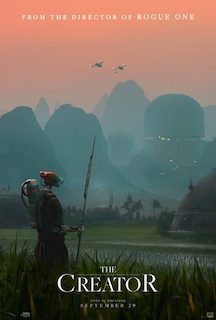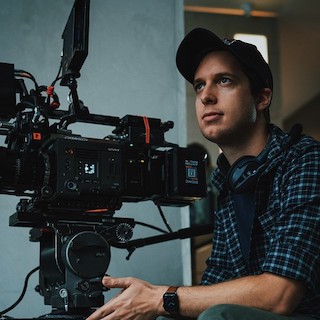 By the time last year when cinematographers Greig Fraser and Oren Soffer were signed to work on the feature film The Creator, director Gareth Edwards had already spent more than a year doing test shoots and location scouting. Edwards said he used that time as the opportunity to envision the look of the film. He went to Vietnam, Cambodia, Japan, Indonesia, Thailand, and Nepal. He said, “Our whole plan was just to go to the greatest locations in the world, because the cost of a flight is way less than the cost of building a set.” Considering the budget of just over $86 million, the filmmakers utilized guerrilla filmmaking methods by having very few crew members and natural lighting on set for select on-location scenes, and limited sound recording. I recently spoke via email with Soffer to learn more about how The Creator was shot.
By the time last year when cinematographers Greig Fraser and Oren Soffer were signed to work on the feature film The Creator, director Gareth Edwards had already spent more than a year doing test shoots and location scouting. Edwards said he used that time as the opportunity to envision the look of the film. He went to Vietnam, Cambodia, Japan, Indonesia, Thailand, and Nepal. He said, “Our whole plan was just to go to the greatest locations in the world, because the cost of a flight is way less than the cost of building a set.” Considering the budget of just over $86 million, the filmmakers utilized guerrilla filmmaking methods by having very few crew members and natural lighting on set for select on-location scenes, and limited sound recording. I recently spoke via email with Soffer to learn more about how The Creator was shot.
Digital Cinema Report: The Creator was shot with what is essentially a high-end consumer camera. I'm reminded of the Dogme movement. Was cost the only factor in using the Sony FX3?
Oren Soffer: The FX3 was chosen as an extension of the methodology director Gareth Edwards was interested in fostering on the film. In an effort to embrace an immersive, authentic filmmaking approach, and inspired by Gareth's approach in making his first feature film Monsters, we sought out a very small and lightweight camera that still provided a robust image for post-production and visual effects purposes, and that could be paired with a Ronin RS2 gimbal to be operated for extended takes and with massive flexibility and freedom to move around a location and react spontaneously to what the actors were doing, or to something happening just outside of frame Gareth would catch out of the corner of his eye.
One of the unique things about this film is that Gareth operated the camera himself in order to be able to react in real time to spontaneous occurrences on set and would often shoot 30-minute extended takes with the actors, going over actions a few times and discovering different angles and approaches to playing and covering a scene in the moment with them, like a kind of dance.
 DCR: How did the camera perform?
DCR: How did the camera perform?
OS: The FX3, being a very small and lightweight camera, paired with its capacity to record a robust ProRes RAW video file format to an external Atomos Ninja recorder, emerged as the right tool for the job after some testing conducted by Greig and Gareth early in the prep process.
One other thing Greig, Gareth and myself were very impressed with was the camera's dual native ISO, the higher of which sits at 12,800 ISO, unheard of in other cinema cameras, but another key component to our filmmaking approach as it allowed us to really embrace natural and available light in the various real-world locations we shot a vast majority of the movie in, without requiring us to heavily light locations and sets with big movie lights but instead allowing us to adopt a much smaller footprint approach that helped keep us nimble and flexible on shoot days, while also leaning into the hyper-naturalistic lighting aesthetic we set out to achieve with the film. Overall, the camera I think really surprised all of us with the quality of image it was able to produce, especially considering its price point.
DCR: What were the camera's pluses and minuses?
OS: Worth noting that the camera is not without its limitations that we had to work around. First and foremost, the camera is simply not really designed to be shot in the way that we used it, so we had to come up with quite a few custom rigging solutions in order to utilize some of the other equipment we intended to use on the film including dollies, cranes, and drones. [We also had to come] up with a custom handheld gimbal rig with the aforementioned Ronin RS2 at its core as the A camera set-up for a majority of the film. It also took quite a bit of work and research to figure out things like timecode sync, video output (as the camera is only equipped with a single HDMI port to send out video), anamorphic desqueeze, and other little technical details, [We also had to work] around other limitations such as a lack of higher frame rates that it can shoot. But still, despite the limitations, we were able to figure out our workarounds thanks to our tenacious camera crew including 1st AC Krittabhat 'Aey' Khieolek, data wrangler Teevarit 'Cho' Pirompapachok, gaffer Pithai Smithsuh who is a cinematographer himself. He also helped build out our camera rig, as well as the entire team at Fotokem LA. I think everyone involved was really impressed with the capabilities of the camera.
DCR: What lenses did you use?
OS: We shot 95 percent of the film on a Kowa Cine Prominar 75mm anamorphic lens. We carried three of these lenses to allow us to have multiple camera rigs ready to shoot at any given time, and this once again gave us the freedom and nimbleness needed to adopt Gareth's guerilla filmmaking approach by removing the need to even swap lenses. The 75mm was chosen as it most closely resembles the perspective and compression of the human eye (equivalent to roughly a 37mm spherical lens), which creates a very immersive and subjective experience for an audience, really placing and grounding them into the world of the film, which was our ultimate goal. Gareth was also very interested in the aberrations and characteristics of vintage anamorphic lenses, as the look of classic films from the ‘70s and ‘80s such as Alien and Blade Runner that shot on similar lenses was a big influence on this film as well. We also carried a prototype 42mm Atlas Mercury anamorphic lens for a few tight quarter spaces such as car interiors where the 75mm just wasn't quite wide enough to get the framing we needed, as well as a set of Ironglass rehoused vintage Soviet stills lenses that we used very sparingly, mostly for some drone work and to shoot some visual effects plate footage.
The Creator opens in theatres on September 29.
